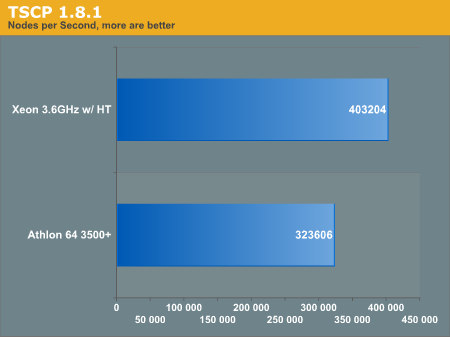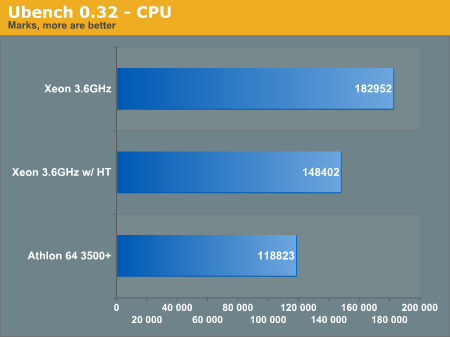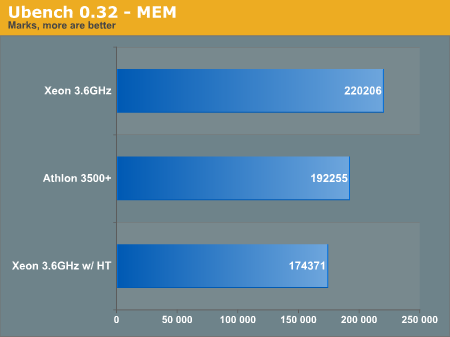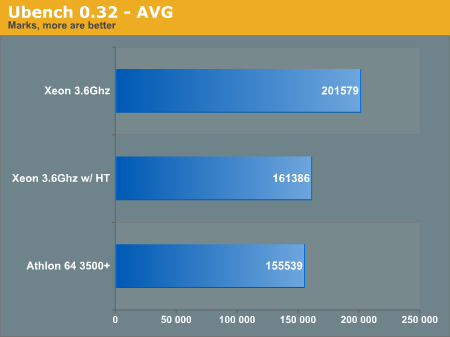Linux and EM64T; Intel's 64-bit Suggestion
by Kristopher Kubicki on August 9, 2004 12:05 AM EST- Posted in
- Linux
Synthetic Benchmarks (continued)
TSCP
TSCP is a simple chess program, which you may read more about here. We compiled the program using our own Makefile, which you can download here. Once compiled, we ran the "bench" command inside the program. Using the -m64 flags provided no change in performance.
As you can see, there appears to be no advantage with HyperThreading for this application. This also appears to be the largest lead that the Intel processor takes over the AMD during the duration of our analysis.
Update:We have retested this part of the benchmark with the -O2 flag in the correct place for both machines. The score has changed to reflect this. br>
ubench
Finally, we have ubench, which stands as the definitive Unix synthetic benchmark. Feel free to learn more about the program here. We compiled the program using ./configure and make with no optimizations. The benchmark was run on a loop ten times to assure that we were getting a true average.


Here, we see HyperThreading working against the Xeon processor in a distinct fashion. According to the Ubench website, both of these machines with single processors outperform dual Xeon 2.4GHz machines, even though they are only running on one processor. The program runs several math-intensive floating point and integer operations over the course of three minutes.










275 Comments
View All Comments
Denial - Monday, August 9, 2004 - link
Doesn't Anand usually author the CPU articles himself? You'd think he would have definitely written this article since it represents such a major change in CPU's. I get the feeling he didn't want his name associated with the article or the chip.TechnoBabble - Monday, August 9, 2004 - link
I can't even believe someone did a review of a Xeon processor and a 64-Bit Athlon. Did the "author" even realize that the cache on the AMD was HALF of the cache on the Intel? Did he even DO any research on these two chips? I mean c'mon...let's rate apples to apples here. Or are the rmors correct and is this guy just a fan-boy or a payola-recipient of Intel??Hey, I have an idea...why don't you do the next "review" between a P4 EE and a Sempron? That would make for some GREAT reading just like this review did!!
Lucky this isn't a paysite because there could be a mass-exodus because of this crap-tacular article.
GEEZ...maybe Tom ISN'T that bad...
JGunther - Monday, August 9, 2004 - link
Such bad press all over tech websites... primer or no, if I were someone over there at AnandTech, I'd rip this thing down before it does any more damage to the site's reputation.opposable - Monday, August 9, 2004 - link
AnandTech has a right to compare any processor they wish. I don't care if they compared the Celeron to the Opteron, so long as the benchmarks and review were articulate and accurate. The cloudiness over what 'bit' some of the benchmarks were run at, the discrepancy between the benchmarks in the article and benchmarks from other sources (including AnandTech itself), and the errors and omissions are what really struck me about this article.I don't care if this was a 'primer,' it was poorly articulated, inadequate, and in some places potentially wrong. I certainly hope that this is not a trend, for AnandTech's sake.
JGunther - Monday, August 9, 2004 - link
An actual 3.6GHz Pentium4 (still a heck of a lost more costly than a 3500+) is compared at Ace's Hardware to some of AMD's offerings. Check it out here:http://www.aceshardware.com/read.jsp?id=65000316
It's not a 3.6F, but from what we've heard, 64bits shouldn't much affect 32bit performance.
Sorry if this has been posted before.
liquidrage2000 - Monday, August 9, 2004 - link
What I don't like about the review is that while the everyday visitor to the site is technical, these reviews show up in searches by people that are not technical.The two CPU's are not geared for the same market, and they aren't priced in the same ballpark.
Hell, the blurb on /. basically just said in a nutshell that Intel thrashed AMD.
So ignoring all the errors and problems with numbers, reviews like this shouldn't be published in this manner unless it's very clear that you're comparing apples to oranges. And it's not clear. Something like "Intel's Server line vs AMD's lowend new desktop" would be better. But overall, you just shouldn't have done this review. It's misleading.
RyanVM - Monday, August 9, 2004 - link
"Relax, its just a primer for future articles. A 3.6F is supposed to compare with a "3600+" rated Athlon 64 isnt it?"Be sure to let me know where I can buy a 3.6F for $350.
JGunther - Monday, August 9, 2004 - link
Viditor: Then why make it? Surely the FX-53 would have made for a better, if still not entirely fair (desktop vs. server) comparison.JGunther - Monday, August 9, 2004 - link
Hrm... just punched in the numbers, and the Intel CPU here is a laughable 240% more expensive than the AMD unit. Let's see the next part of this review: The AMD Opteron 250 vs. the P4 3.4GHz Northwood. Same price ratio.Haha better yet, let's see the A64 3500+ against the P4 2.6GHz w/ 533FSB. Again, 240% price difference.
Viditor - Monday, August 9, 2004 - link
"How, by any stretch of the imagination, is this a good comparison"Kris actually acknowledged that it wasn't in the review...
His point was to try and predict what the P4f will be like when it is finally released.
The only real problems with the review if looked at in that light are:
1. Many of the results appear to be in error
2. Only 1 gig of ram was used on a 64-bit system
3. He mixed 32 bit and 64 bit apps without being completely clear on it
4. He didn't publish memory timings
It has been speculated that he made errors with his makefile, and that he didn't compile for AMD when he tested the A64...